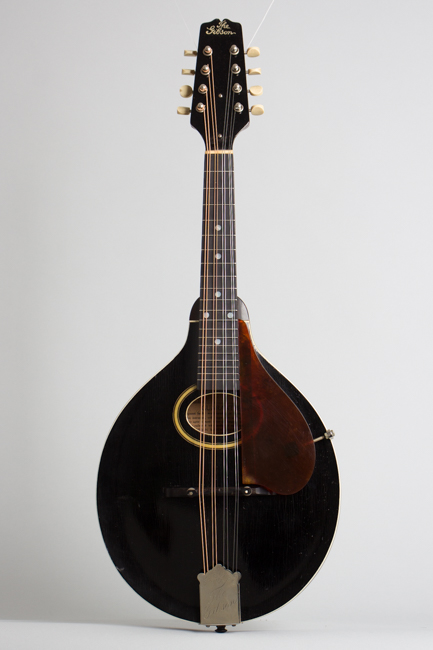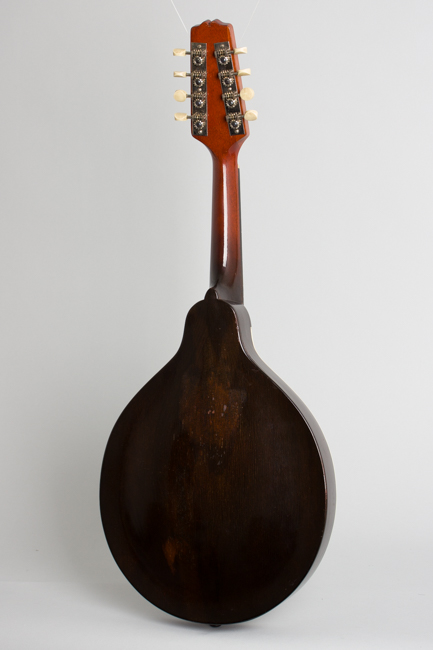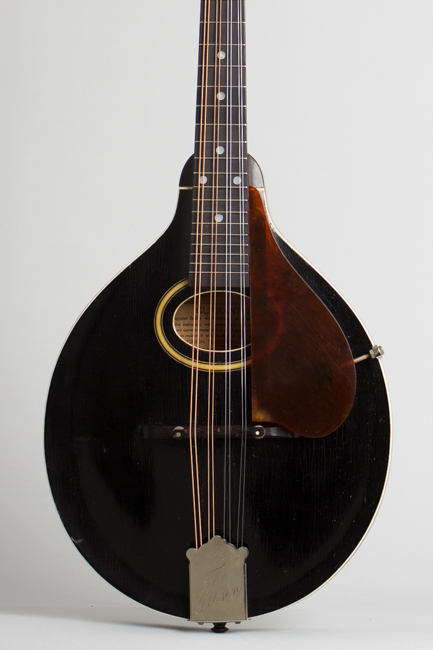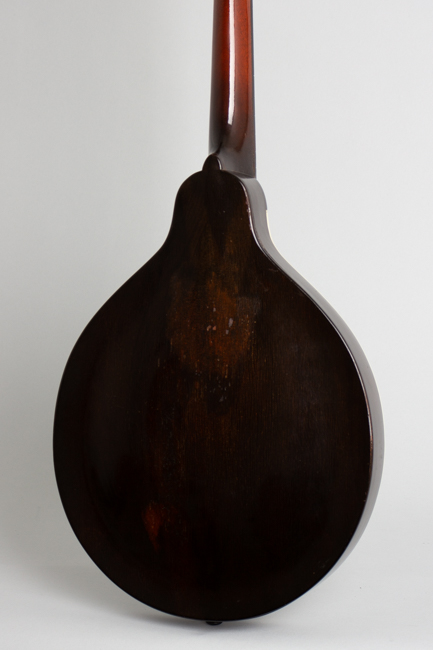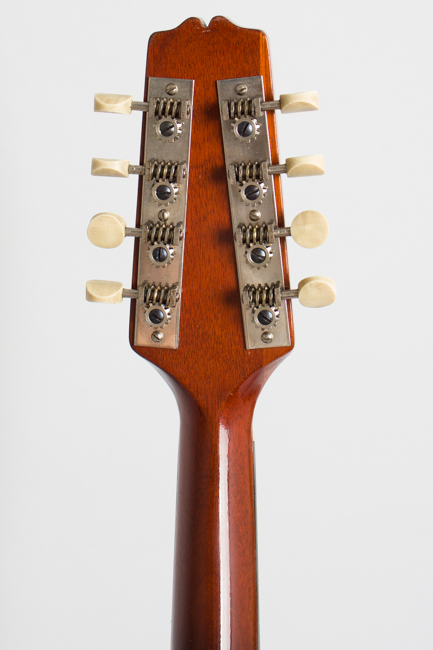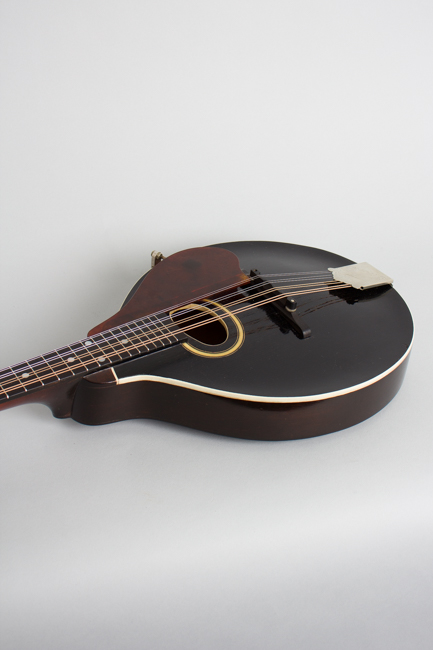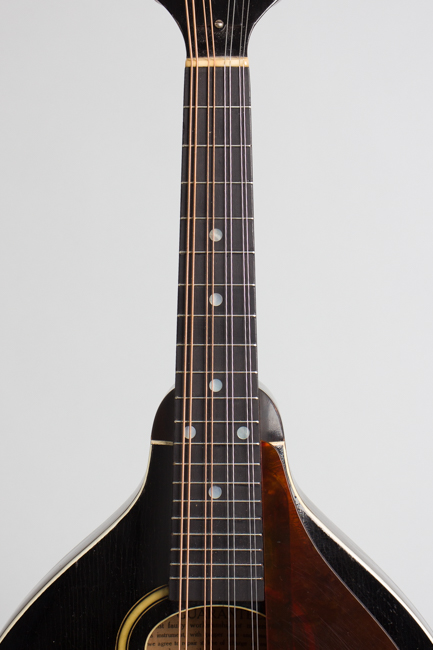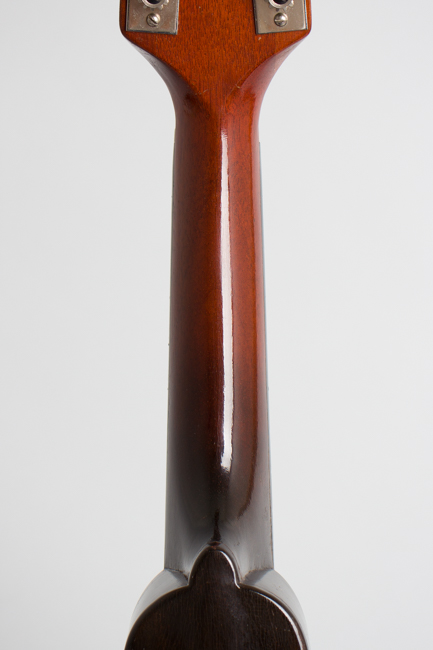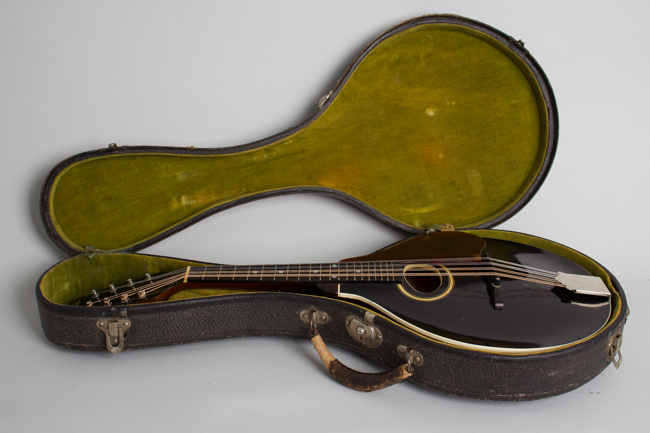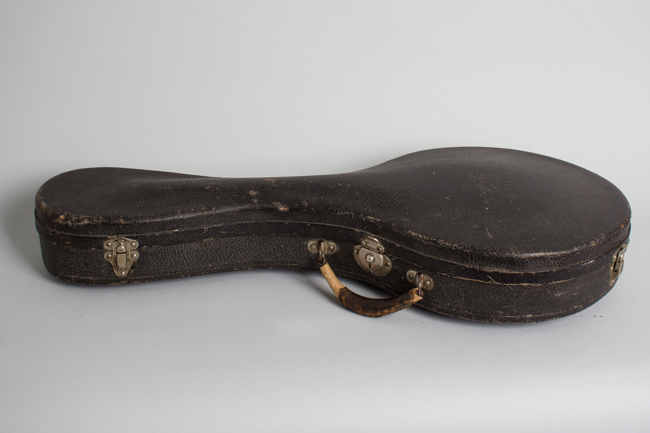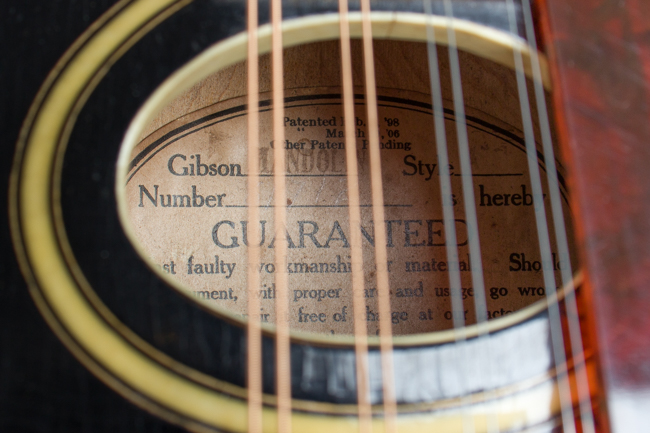Gibson Style A Snakehead Carved Top Mandolin (1927)
This item has been sold.
Item # 11615
Prices subject to change without notice.
Gibson Style A Snakehead Model Carved Top Mandolin (1927), made in Kalamazoo, Michigan, serial # 81712, black top, dark stained back and sides finish, birch back and sides, spruce top, mahogany neck with ebony fingerboard, original black hard shell case.
This is a clean, great-playing and sounding original Style A-1 mandolin from mid- 1927, the "post-Loar era" at Gibson. These Loar-pattern "Snakeheads" are generally considered the best-sounding oval-hole A style mandolins ever made, and this one certainly bears this out. This is a fine example of Gibson's continued craftsmanship at the end of the mandolin era, as the company's focus was shifting to banjos and then guitars.
These "Snakehead" instruments are named for their Loar-designed peghead that angles inward towards the tip, a feature inexplicably abandoned by Gibson not long after this one was made. They are revered for their unmatched tone and projection and have the other advanced features of the era including the adjustable truss rod in the neck, raised adjustable bridge, and very slim neck profile. The top on this Style A bears a striking black lacquer finish, bound in white celluloid with a thin double inlaid soundhole ring with a celluloid center. The tailpiece has the engraved "The Gibson" cover plate and the tuners are simple strips with composite buttons. The headstock has a silkscreen "The Gibson" logo, oriented straight across instead of the slanted angle used previously.
These distinctive "snakehead" A mandolins have long been sought-after by discerning players. Lloyd Loar's tenure as acoustic engineer at Gibson has become so mythical that sometimes separating fact from fiction is difficult. Certainly the mandolin family instruments made during the period of his employment are the most perfectly realized in Gibson's history, and have become the template for most similar instruments since.
The mandolins of this period show the influence of a master player on both design and execution, although other Gibson employees (especially Thaddeus McHugh and Lewis A. Williams) actually engineered many of the technical improvements of the early 1920's. Loar was primarily concerned with 'voicing' the instruments properly; the Master Model Style 5 line was his greatest contribution but all Gibson mandolin family instruments were refined and improved at the same time. Even this fairly basic "A" model has sonic and playing improvements benefitting from "Master Loar's" input that are still evident today, nearly 100 years on.
Overall length is 25 3/4 in. (65.4 cm.), 10 in. (25.4 cm.) wide, and 1 7/8 in. (4.8 cm.) in depth, measured at side of rim. Scale length is 14 in. (356 mm.). Width of nut is 1 1/16 in. (27 mm.).
This is a lovely, beautifully original "Snakehead" A showing only very minor wear, wear really looking not too much used over the last 95 years. The finish has some noticeable checking to the top and headstock face. There is finer checking on the back with some small spots flaked off; that is sometimes the case with Gibsons from right around this time when they were still perfecting their lacquer finishing technique. Overall the instrument shows some small dings, dents and scrapes but no really heavy wear.
There is no evidence of any crack repairs, as is common a couple of spots along the back/edge seams look to have been resealed. All hardware is original and intact including the tuners, bridge, tailpiece and cover. The pickguard has a small spot of celluloid outgassing on the back edge that has been stabilized with Epoxy; the support bar underneath has been replaced (that glued-on is often the source of any celluloid issues). The original frets have been neatly dressed and the mandolin plays and sounds spectacular, with a powerful bark and a huge ring. It still resides in its original hardshell case, a bit worn but fully intact. Overall Excellent Condition.
This is a clean, great-playing and sounding original Style A-1 mandolin from mid- 1927, the "post-Loar era" at Gibson. These Loar-pattern "Snakeheads" are generally considered the best-sounding oval-hole A style mandolins ever made, and this one certainly bears this out. This is a fine example of Gibson's continued craftsmanship at the end of the mandolin era, as the company's focus was shifting to banjos and then guitars.
These "Snakehead" instruments are named for their Loar-designed peghead that angles inward towards the tip, a feature inexplicably abandoned by Gibson not long after this one was made. They are revered for their unmatched tone and projection and have the other advanced features of the era including the adjustable truss rod in the neck, raised adjustable bridge, and very slim neck profile. The top on this Style A bears a striking black lacquer finish, bound in white celluloid with a thin double inlaid soundhole ring with a celluloid center. The tailpiece has the engraved "The Gibson" cover plate and the tuners are simple strips with composite buttons. The headstock has a silkscreen "The Gibson" logo, oriented straight across instead of the slanted angle used previously.
These distinctive "snakehead" A mandolins have long been sought-after by discerning players. Lloyd Loar's tenure as acoustic engineer at Gibson has become so mythical that sometimes separating fact from fiction is difficult. Certainly the mandolin family instruments made during the period of his employment are the most perfectly realized in Gibson's history, and have become the template for most similar instruments since.
The mandolins of this period show the influence of a master player on both design and execution, although other Gibson employees (especially Thaddeus McHugh and Lewis A. Williams) actually engineered many of the technical improvements of the early 1920's. Loar was primarily concerned with 'voicing' the instruments properly; the Master Model Style 5 line was his greatest contribution but all Gibson mandolin family instruments were refined and improved at the same time. Even this fairly basic "A" model has sonic and playing improvements benefitting from "Master Loar's" input that are still evident today, nearly 100 years on.
Overall length is 25 3/4 in. (65.4 cm.), 10 in. (25.4 cm.) wide, and 1 7/8 in. (4.8 cm.) in depth, measured at side of rim. Scale length is 14 in. (356 mm.). Width of nut is 1 1/16 in. (27 mm.).
This is a lovely, beautifully original "Snakehead" A showing only very minor wear, wear really looking not too much used over the last 95 years. The finish has some noticeable checking to the top and headstock face. There is finer checking on the back with some small spots flaked off; that is sometimes the case with Gibsons from right around this time when they were still perfecting their lacquer finishing technique. Overall the instrument shows some small dings, dents and scrapes but no really heavy wear.
There is no evidence of any crack repairs, as is common a couple of spots along the back/edge seams look to have been resealed. All hardware is original and intact including the tuners, bridge, tailpiece and cover. The pickguard has a small spot of celluloid outgassing on the back edge that has been stabilized with Epoxy; the support bar underneath has been replaced (that glued-on is often the source of any celluloid issues). The original frets have been neatly dressed and the mandolin plays and sounds spectacular, with a powerful bark and a huge ring. It still resides in its original hardshell case, a bit worn but fully intact. Overall Excellent Condition.
